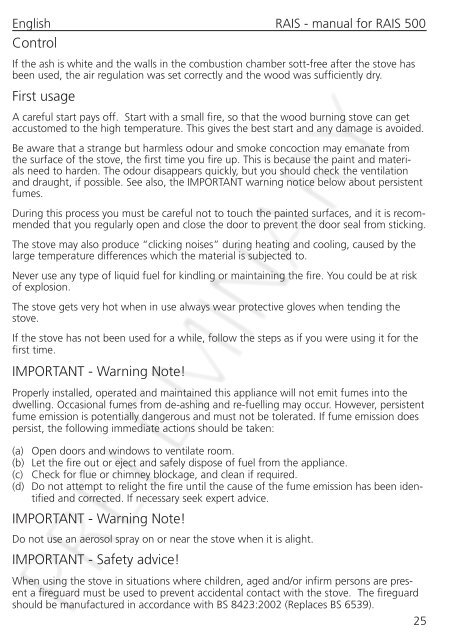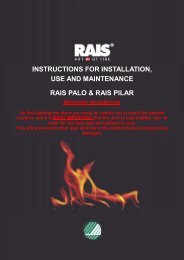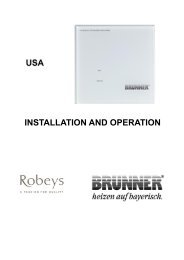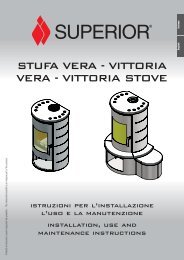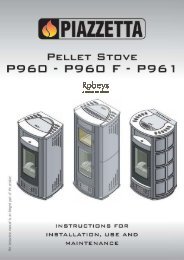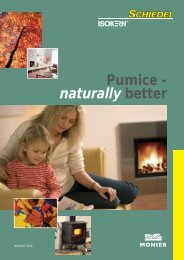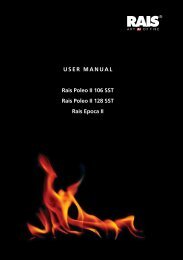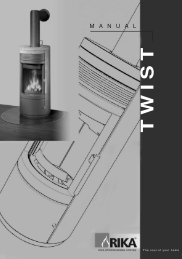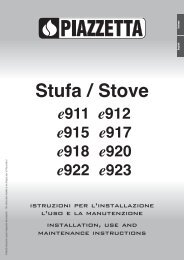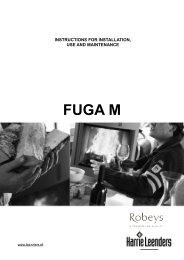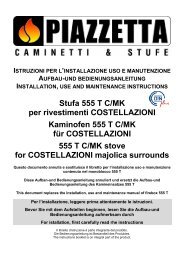USER MANUAL RAIS 500 - Robeys Ltd
USER MANUAL RAIS 500 - Robeys Ltd
USER MANUAL RAIS 500 - Robeys Ltd
Create successful ePaper yourself
Turn your PDF publications into a flip-book with our unique Google optimized e-Paper software.
English <strong>RAIS</strong> - manual for <strong>RAIS</strong> <strong>500</strong><br />
Control<br />
If the ash is white and the walls in the combustion chamber sott-free after the stove has<br />
been used, the air regulation was set correctly and the wood was sufficiently dry.<br />
First usage<br />
A careful start pays off. Start with a small fire, so that the wood burning stove can get<br />
accustomed to the high temperature. This gives the best start and any damage is avoided.<br />
Be aware that a strange but harmless odour and smoke concoction may emanate from<br />
the surface of the stove, the first time you fire up. This is because the paint and materials<br />
need to harden. The odour disappears quickly, but you should check the ventilation<br />
and draught, if possible. See also, the IMPORTANT warning notice below about persistent<br />
fumes.<br />
During this process you must be careful not to touch the painted surfaces, and it is recommended<br />
that you regularly open and close the door to prevent the door seal from sticking.<br />
The stove may also produce “clicking noises” during heating and cooling, caused by the<br />
large temperature differences which the material is subjected to.<br />
Never use any type of liquid fuel for kindling or maintaining the fire. You could be at risk<br />
of explosion.<br />
The stove gets very hot when in use always wear protective gloves when tending the<br />
stove.<br />
If the stove has not been used for a while, follow the steps as if you were using it for the<br />
first time.<br />
IMPORTANT - Warning Note!<br />
Properly installed, operated and maintained this appliance will not emit fumes into the<br />
dwelling. Occasional fumes from de-ashing and re-fuelling may occur. However, persistent<br />
fume emission is potentially dangerous and must not be tolerated. If fume emission does<br />
persist, the following immediate actions should be taken:<br />
(a) Open doors and windows to ventilate room.<br />
(b) Let the fire out or eject and safely dispose of fuel from the appliance.<br />
(c) Check for flue or chimney blockage, and clean if required.<br />
(d) Do not attempt to relight the fire until the cause of the fume emission has been identified<br />
and corrected. If necessary seek expert advice.<br />
IMPORTANT - Warning Note!<br />
Do not use an aerosol spray on or near the stove when it is alight.<br />
IMPORTANT - Safety advice!<br />
PRELEMINARY<br />
When using the stove in situations where children, aged and/or infirm persons are present<br />
a fireguard must be used to prevent accidental contact with the stove. The fireguard<br />
should be manufactured in accordance with BS 8423:2002 (Replaces BS 6539).<br />
25


